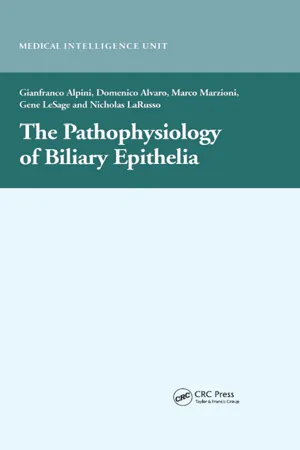
- 464 pages
- English
- ePUB (mobile friendly)
- Available on iOS & Android
The Pathophysiology of Biliary Epithelia
About this book
This book is a comprehensive review of the biliary epithelia pathophysiology. Biliary epithelial cells (also referred to as cholangiocytes) line the intra- and extrahepatic bile ducts. Cholangiocytes have immerged in the last several years as one of the more important epithelial cells in the gastrointestinal system due to their large contribution to bile formation and tendency to be involved in human diseases.
The book's 35 chapters represent a nearly complete review of the function and disease of bile ducts. The gestational development of bile ducts is shown to be a complex interaction between hepatocyte and biliary precursors. The structure of bile ducts can be defined by ultrastructural studies and by 3D reconstruction studies which show that the bile duct system resembles a tree. The array of membrane transporters and channels involved in ductal absorption and secretion of water and electrolytes is reviewed. Like other gastrointestinal epithelial cells, the physiologic responses of cholangiocytes are regulated by hormones, nerve input, cytokines, factors in bile and intracellular signals (e.g., cyclic AMP and intracellular calcium). The potential role of the cholangiocyte in production of collagen in cholestatic liver disease is discussed. A number of important models used in the study of cholangiocyte physiology and reactions to injury are reviewed. Finally the relationships between the cholangiocyte responses and human liver diseases are discussed.
While many basic scientists and hepatologists who devote their careers to the study of the liver will find this book useful, the intended audience of this book is the more heterogeneous group of individuals who study clinical and/ or basic science digestive physiology and due to their interest in epithelial function will find the cutting edge information in this book both enlightening and useful to their progression of their work.
Frequently asked questions
- Essential is ideal for learners and professionals who enjoy exploring a wide range of subjects. Access the Essential Library with 800,000+ trusted titles and best-sellers across business, personal growth, and the humanities. Includes unlimited reading time and Standard Read Aloud voice.
- Complete: Perfect for advanced learners and researchers needing full, unrestricted access. Unlock 1.4M+ books across hundreds of subjects, including academic and specialized titles. The Complete Plan also includes advanced features like Premium Read Aloud and Research Assistant.
Please note we cannot support devices running on iOS 13 and Android 7 or earlier. Learn more about using the app.
Information
CHAPTER 1
Normal and Abnormal Development of the Biliary Tree
James M. Crawford
Introduction
Anatomy
Generation | ||
|---|---|---|
Major bile ducts | Grossly visible branches of the biliary system (common hepatic; right/left hepatic; segmental; area) | 0–3 |
Conducting bile ducts | Ramify through liver, supply terminal bile ducts | 3-~17 |
Terminal bile ducts | Smallest branches of portal tract-based biliary system | ≥~17 |
Bile ductule Canal of Hering | Tubular channel linking terminal bile duct to canal of Hering A biliary channel lined partially by biliary epithelium (cholangiocytes) and partially by hepatocytes: -situated at the peripheral rim of portal tracts or -penetrating the parenchyma in the periportal region | |
NOTE: “conducting” bile duct = “septal” bile duct = “sublobular” bile duct “terminal” bile duct = “interlobular” bile duct “Generation” refers to branch number. * From reference 1. | ||
18 day embryo: | liver bud arises as thickened endodermal epithelium from foregut |
22 day embryo: | hepatic diverticulum protrudes into mesenchyme of septum transversum |
23 day embryo: | endodermal “cords” of hepatoblasts invade mesenchyme |
23-24 days: | hepatoblasts express a-fetoprotein, albumin |
3-8 weeks: | hepatoblasts express CK4, CK18, CK19, CK14; hepatic duct becomes patent |
8-12 weeks: | "ductal plate” develops, from hilum outwards (centrifug... |
Table of contents
- Cover
- Title Page
- Copyright Page
- Table of Contents
- Editors
- Contributors
- Preface
- 1. Normal and Abnormal Development of the Biliary Tree
- 2. Human Liver Stem Cells: Recent Developments
- 3. Vascularization of the Intrahepatic Biliary Tree and Its Role in the Regulation of Cholangiocyte Growth
- 4. Ultra-Structural Analysis of the Intrahepatic Bile Duct System
- 5. Three-Dimensional Reconstruction of the Rat Intrahepatic Biliary Tree: Physiological Implications
- 6. Cholangiocyte Ion Channels: Targets for Drug Development
- 7. Effects of Cytokines and Nitric Oxide on Bicarbonate Secretion by Cholangiocytes
- 8. Hormonal Regulation of Cholangiocyte Secretion
- 9. Purinergic Regulation of Bile Ductular Secretion
- 10. Calcium Signaling in Cholangiocytes
- 11. Bile Acid Interactions with Cholangiocytes
- 12. Aquaporin-Mediated Water Transport in Intrahepatic Bile Duct Epithelial Cells
- 13. ABC Transporters, Organic Solute Carriers and Drug Metabolising Enzymes in Bile Duct Epithelial Cells
- 14. Regulation of Secretion in Human Gallbladder Epithelial Cells
- 15. Ductal Bicarbonate Secretion in Human Cholestatic Liver Diseases
- 16. Participation of Cytokines and Growth Factors in Biliary Epithelial Proliferation and Mito-Inhibition during Ductular Reactions
- 17. Estrogen Regulation of Cholangiocyte Proliferation
- 18. Nerve Regulation of Cholangiocyte Functions
- 19. Cholestasis and Fibrogenesis
- 20. Apoptosis of Biliary Epithelial Cells
- 21. Cytokine Regulation of Cholangiocyte Growth
- 22. Fas-Mediated Cholangiopathy in a Murine Model of Graft-versus-Host Disease
- 23. Functional Heterogeneity of the Intrahepatic Biliary Epithelium
- 24. In Vitro Systems for the Study of the Intrahepatic Biliary Epithelium
- 25. Mouse Knockout Models of Biliary Epithelial Cell Formation and Disease
- 26. Drug-Induced Vanishing Bile Duct Syndromes
- 27. Biliary Atresia
- 28. Primary Biliary Cirrhosis Bench to Bedside
- 29. Immunopathogenesis of Vanishing Bile Duct Syndromes
- 30. Cryptosporidium and Bile Duct Injury
- 31. Liver Disease in Cystic Fibrosis
- 32. Medical Treatment of Vanishing Bile Duct Syndrome in Adults
- 33. Ursodeoxycholic Acid Treatment of Vanishing Bile Duct Syndromes
- 34. Liver Transplantation for Adult Vanishing Bile Duct Syndromes
- 35. Pathology of the Intrahepatic Biliary Tree after Liver Transplantation
- Index